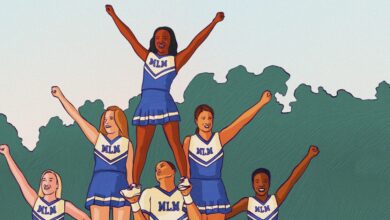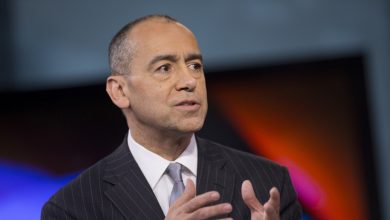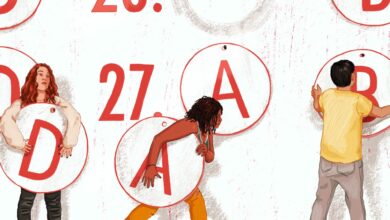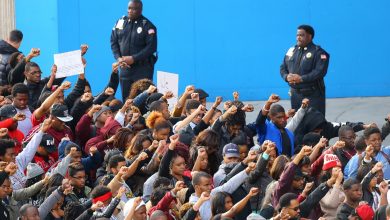The Department Chair Goes Back to the Classroom, Finally
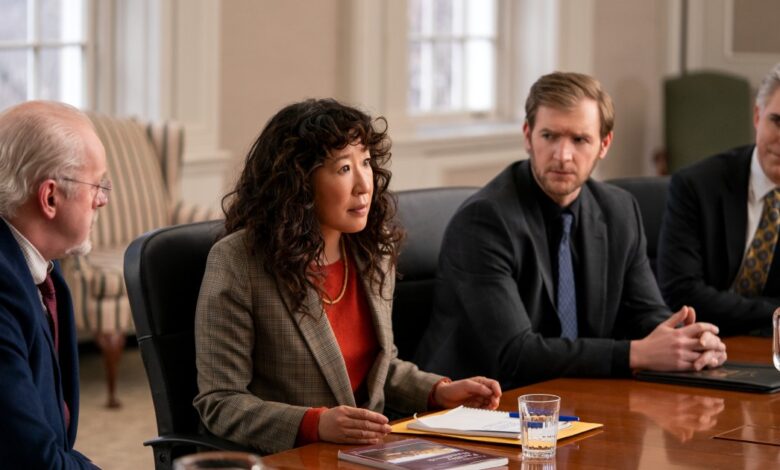
[ad_1]
You’re reading a recap of Episode 6 of the Netflix series The Chair with the writers Alison Kinney, Grace Lavery, Dan Sinykin, and Rebecca Wanzo. Find our other episode recaps here.
The following has been edited for length and clarity.
Rebecca: I am actually shocked by how much I enjoyed this series. One of the things I liked most about it is that it ends with Ji-Yoon in the classroom giving us just a bit of close reading — this is not Barbra Streisand in The Mirror Has Two Faces pontificating on love. There is an actual text in this class. We get to see that she loves teaching, that even after what she’s lost, literature, language, and pedagogy center her. I love Emily Dickinson, but the choice of this particular poem and the interpretative work feels deeply clichéd. That said, it’s a rarity to see depictions of teaching in which both faculty and students take joy in the actual content of the texts.
An ongoing question Grace has been asking is “What does The Chair want?” It’s a sitcom, so on one level it wants people to laugh. But on another level, it’s an old-fashioned defense of the value of English departments and the university as spaces of intellectual engagement. That defense happens very quickly at the end of the episode. Ji-Yoon defends the students, she returns happily to the classroom, and Bill demonstrates a deep investment in his students’ work. The everydayness of what is good about the profession is a coda, but of course mundane joys won’t produce an interesting comedy.
Dan: Earlier I worried that The Chair might be bidding farewell to English, depicting us as inadequate to our moment. I was wrong. And I was right. I was wrong for the reason you point out, Rebecca. I, too, delighted in the opportunity to see Ji-Yoon in action. She is passionate, at home in herself. Her students — unlike in many other classroom scenes in this show — are engaged and alert to Emily Dickinson’s language.
It’s a scene of “refuge” — the word Ji-Yoon uses when, during Bill’s hearing, she changes her mind and decides to defend him. She says the university is supposed to be “refuge from the bullshit.” Her speech to the dean is the show’s structural turn. She observes that the students’ protests against Bill aren’t about Bill. They’re about the college’s failure to retain faculty of color, to serve as a refuge for its students of color, and to imagine itself as anything but an alibi for the bullshit. Pembroke operates as if its job is, in Ji-Yoon’s words, to “trick them or manage them or make them fall in line.” It’s a truism we all know: The university regards students as consumers to be satisfied.
So Dickinson is refuge — and it’s beautiful. But it’s also not enough. This is why I wasn’t wrong when I worried the show would depict us as inadequate to our moment. Pembroke is a certain kind of college. It’s not an Ivy, but it’s close. For all its troubles, it has enough prestige, and enough of an endowment, that it can afford to be a refuge: to occlude the fact that most people who teach at institutions of higher ed in this country are adjuncts, without offices, or health insurance, or job stability — lucky if they scrabble together $30,000 in a year.
Pembroke can fire Bill, Ji-Yoon says, but unless it fundamentally changes, its students won’t rest. We also have no indication that Pembroke will change — nor, truthfully, that the faculty will do anything to advocate for change. Refuge in Dickinson is beautiful fatalism.
And so the hope with which the show ends, the thing with feathers, feels like a false promise. It feels as if the show is a benediction after all, a bittersweet one, one that believes in us and what we do as we sink.
Alison: What you’re saying about the false promise of hope in an — irreparably? — flawed institution feels right. Ji-Yoon’s speech here acts as not only a conclusion to the show, not only a (true and inadequate) answer to the questions we’ve all been asking, but also, perhaps, a corollary to Ji-Yoon’s (failed) lecture on “The Master’s Tools Will Never Dismantle the Master’s House.” Audre Lorde writes, “Difference must be not merely tolerated, but seen as a fund of necessary polarities between which our creativity can spark like a dialectic … only within that interdependency of different strengths, acknowledged and equal, can the power to seek new ways of being in the world generate, as well as the courage and sustenance to act where there are no charters.” “Hope” is too reductive a word to apply to what Lorde was seeking, but maybe there is something like hope in the juxtaposition of these texts and ideals and demands for a better institution. Or, as Bill suggested in his (failed) lecture in Episode 1: hope as continued action, even in the absence of conviction or belief that action can change anything.
Grace: I think “close reading” means different things to different people, which is probably a problem if it’s going to be the lingua franca of our discipline. I know what it feels like: It feels thoughtful, attentive, set aside from the rush of everyday life. For which reason, I can’t agree with Yaz that posting short excerpts of Moby-Dick on Twitter has much to do with it.
We have some other notions of close reading on offer. Dan writes beautifully about Ji-Yoon’s “refuge” model, and I’m utterly seduced by it too (and charmed by Sandra Oh as the delivery vessel). The second part of the phrase that Ji-Yoon uses — ”a refuge from the bullshit” — gives me more pause. What is “the bullshit,” exactly? She’s gesturing out of the window at the kids protesting: Perhaps the bullshit is the virtue-signaling, culture-canceling pseudo-politics that, as we’ve mostly agreed, has been a straw man for The Chair all along. But I’m also concerned that Dickinson is sort of bullshit, and so is love; the humanities might, after all, be construed not merely as a refuge from the bullshit, but a refuge for the bullshit. Jonathan Eburne has argued that one of the principal virtues of our profession is that, even when we have a really bad day at work, nobody dies.
Rebecca: I would also like to talk about Joan’s new status as chair. It should feel like a Pyrrhic victory, but the show treats it as an actual win.
Grace: It’s as though Joan was the secret protagonist all along. After watching the first episode, I was concerned that the women of color would turn out to be ciphers for white women. I don’t think that’s true, but I agree that the show treats Joan’s election after ousting Ji-Yoon as a win, rather than as a coup enacted by the white faculty.
Rebecca: We’ve talked about who The Chair is for, and obviously academics are too small an audience for it to be for us. The show recognizes that academic life is ripe for situation comedy, but it must remain general enough that the humor doesn’t require insider knowledge. The show also understands the generic pleasure of the triumphant women’s narrative — even as it gives us the worst version of it. (It’s not clear to me that Joan will be a good chair, simply because her ability to think outside of her own self-interest seems limited.) Joan’s triumph comes from scapegoating Ji-Yoon as the faculty try to imagine a way out of their general precarity. So much for cross-generational amity. And Joan’s success, as much as it is coded as moving forward, maintains the familiar — largely ineffectual and full of symbolic gestures. But we can feel good that she has the big office!
Grace: My last thought: Twitter and Netflix are also both the master’s house.
[ad_2]
Source link




